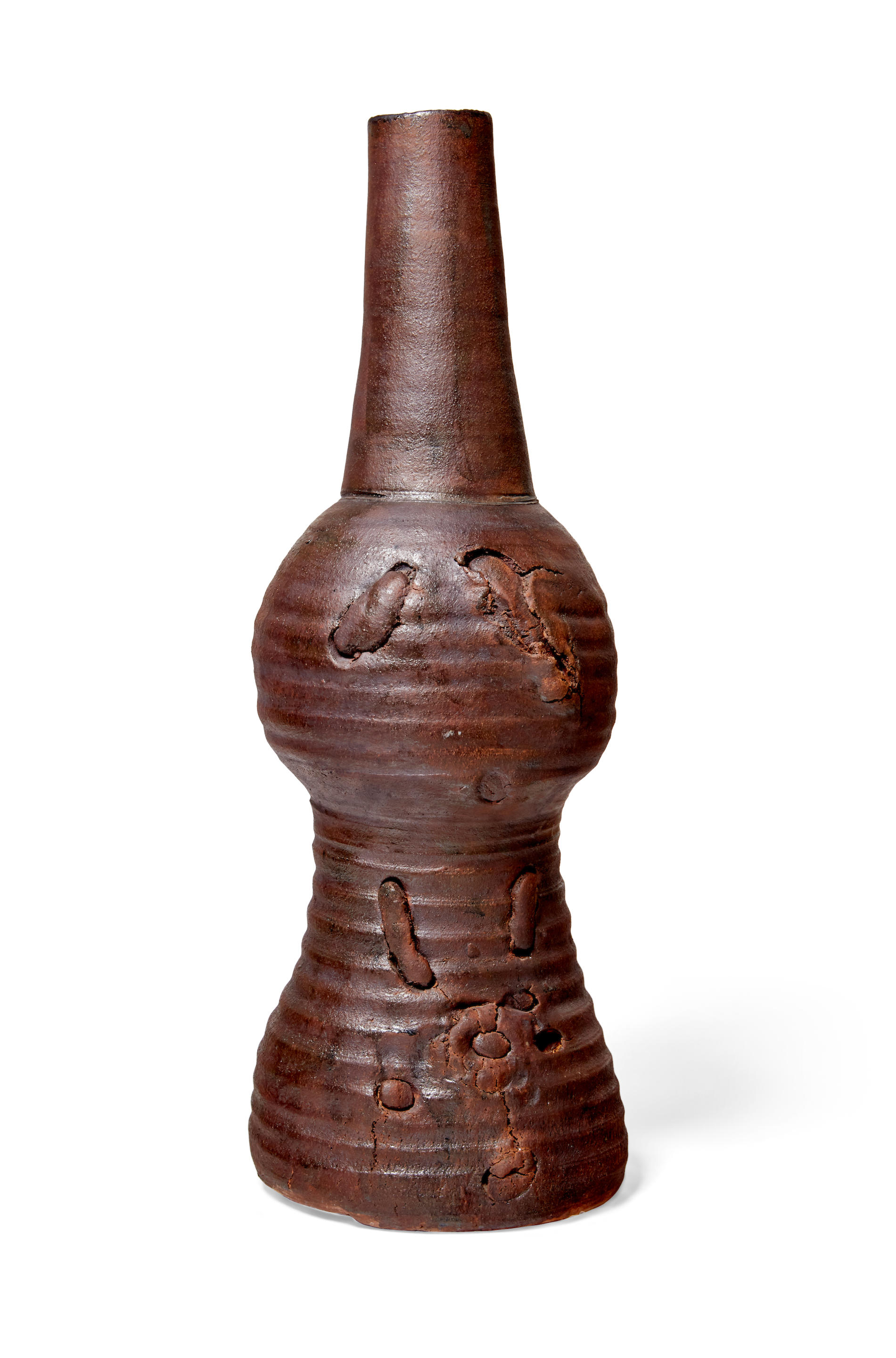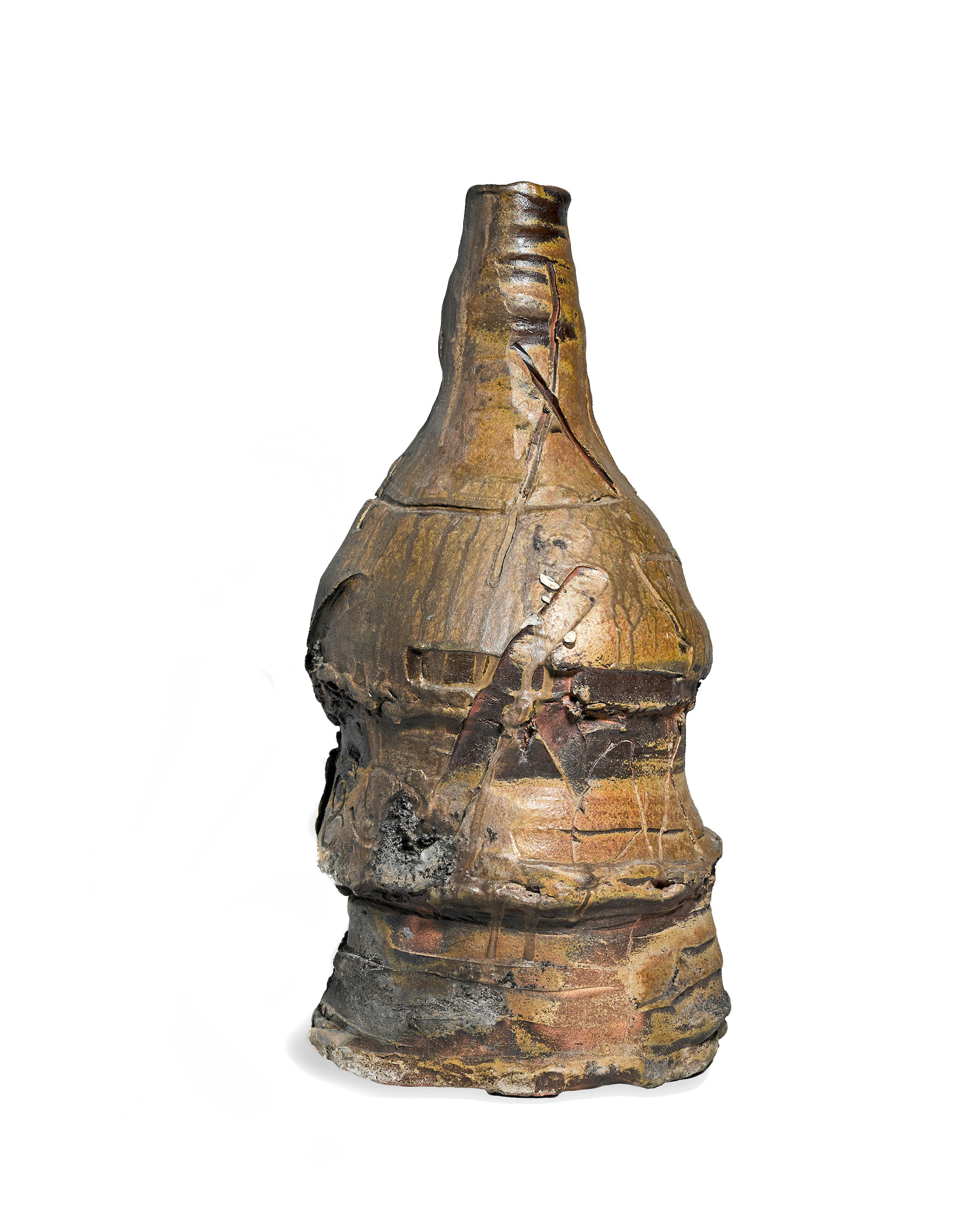Property from a Private Collection, Los Angeles Peter Voulkos Follow Untitled vase signed in iron oxide 'Voulkos/59' on the underside glazed stoneware height 50.8 cm (20 in.) Executed in 1959.
Provenance Junia Cone Margaret (Peggy) Cone Voulkos Thence by descent to Pier Voulkos Acquired from the above by the present owner in 2012 Exhibited Santa Monica, Frank Lloyd Gallery, Peter Voulkos in LA: Time Capsule , 14 January – 11 February 2012, pp. 26-27 (illustrated on cover) Literature Sequoia Miller, The Ceramic Presence in Modern Art: Selections from the Linda Leonard Schlenger Collection and the Yale University Art Gallery , exh. cat., Yale University Art Gallery, New Haven, 2015, p. 30 (a similar example illustrated) Catalogue Essay Slash and Burn Peter Voulkos loved a crowd. Surrounded by admirers from the time he began teaching at the Otis College of Art and Design in Los Angeles in 1954, he seemed to thrive as the center of attention, whether he was playing guitar, talking about art, or – especially – working with clay. A gifted thrower and an adroit improviser, he captivated and surprised his audience, first creating large cylinders and then manipulating them at high speed: slapping them out of round, slicing into their walls, stacking them atop one another, or simply tearing them apart. All the while he would keep up a steady patter of jokes and observations. He was able to create extraordinary avant-garde sculpture while only half paying attention. This was the atmosphere in which Voulkos’s Untitled Vase was created, while at a residency at the Oregon Ceramic Studio in Portland (founded in 1937, later the Museum of Contemporary Crafts). He had demonstrated and exhibited there before, in the early 1950s when he was still practising as a functional potter. His visit in 1959 found him at the absolute height of his creative powers. At the time he was sharing a studio with his colleague John Mason on Glendale Boulevard in Los Angeles. Together the two men had created an ideal (and unique) situation for the realization of large-scale ceramics, outfitted with industrially-scaled mixers, humidifiers and an enormous walk-in kiln. They were perfect studio mates, each driving the other to greater heights of ambition. For Voulkos, 1959 saw an outpouring of monumental sculptures, including the neo-Cubist Sitting Bull (Santa Barbara Museum of Art) and Little Big Horn (Oakland Museum of California); a group of important monochrome works including Tientos (San Francisco Museum of Modern Art), Camelback Mountain (Museum of Fine Arts, Boston), and Hack’s Rock (Hirshhorn Museum); and a pioneering polychromatic work at smaller scale, Cross (Museum of Arts and Design).1 This last work had a particular public impact, as it was one of the key images used in the promotion of the exhibition Objects: USA . Seen at twenty museums in America and ten in Europe, the show defined contemporary craft for a generation; the associated publication remains an essential document of the moment. Voulkos’s work, front and centre in the exhibition, was emblematic of the radical rupture that had occurred in the field. Compared to the other works that Voulkos was realizing at this time, the Untitled Vase made in Portland is relatively modest in scale, just under twenty inches in height ( Cross is thirty inches high, while Sitting Bull is nearly six feet tall). Yet it possesses, in compressed form, many of the key qualities of the artist’s breakthrough. First and most obviously, it is vividly polychrome. Just at this time, Voulkos had begun to experiment with brightly colored low-fire glazes, which ordinarily would not be applied to a stoneware body. He also occasionally added epoxy-based paint to his works, as in an Untitled plate also from 1959 (Milwaukee Art Museum), the great rocket-shaped Red River (1960, Whitney Museum of American Art), and USA 41 (1961, National Gallery of Art). Though his departure from the conventional, sedate palette of stoneware seems uncontroversial in retrospect, it was understood at the time as a statement of radicalism, and a declaration of affinity with contemporaneous Abstract Expressionism. Untitled Vase is, then, one
Property from a Private Collection, Los Angeles Peter Voulkos Follow Untitled vase signed in iron oxide 'Voulkos/59' on the underside glazed stoneware height 50.8 cm (20 in.) Executed in 1959.
Provenance Junia Cone Margaret (Peggy) Cone Voulkos Thence by descent to Pier Voulkos Acquired from the above by the present owner in 2012 Exhibited Santa Monica, Frank Lloyd Gallery, Peter Voulkos in LA: Time Capsule , 14 January – 11 February 2012, pp. 26-27 (illustrated on cover) Literature Sequoia Miller, The Ceramic Presence in Modern Art: Selections from the Linda Leonard Schlenger Collection and the Yale University Art Gallery , exh. cat., Yale University Art Gallery, New Haven, 2015, p. 30 (a similar example illustrated) Catalogue Essay Slash and Burn Peter Voulkos loved a crowd. Surrounded by admirers from the time he began teaching at the Otis College of Art and Design in Los Angeles in 1954, he seemed to thrive as the center of attention, whether he was playing guitar, talking about art, or – especially – working with clay. A gifted thrower and an adroit improviser, he captivated and surprised his audience, first creating large cylinders and then manipulating them at high speed: slapping them out of round, slicing into their walls, stacking them atop one another, or simply tearing them apart. All the while he would keep up a steady patter of jokes and observations. He was able to create extraordinary avant-garde sculpture while only half paying attention. This was the atmosphere in which Voulkos’s Untitled Vase was created, while at a residency at the Oregon Ceramic Studio in Portland (founded in 1937, later the Museum of Contemporary Crafts). He had demonstrated and exhibited there before, in the early 1950s when he was still practising as a functional potter. His visit in 1959 found him at the absolute height of his creative powers. At the time he was sharing a studio with his colleague John Mason on Glendale Boulevard in Los Angeles. Together the two men had created an ideal (and unique) situation for the realization of large-scale ceramics, outfitted with industrially-scaled mixers, humidifiers and an enormous walk-in kiln. They were perfect studio mates, each driving the other to greater heights of ambition. For Voulkos, 1959 saw an outpouring of monumental sculptures, including the neo-Cubist Sitting Bull (Santa Barbara Museum of Art) and Little Big Horn (Oakland Museum of California); a group of important monochrome works including Tientos (San Francisco Museum of Modern Art), Camelback Mountain (Museum of Fine Arts, Boston), and Hack’s Rock (Hirshhorn Museum); and a pioneering polychromatic work at smaller scale, Cross (Museum of Arts and Design).1 This last work had a particular public impact, as it was one of the key images used in the promotion of the exhibition Objects: USA . Seen at twenty museums in America and ten in Europe, the show defined contemporary craft for a generation; the associated publication remains an essential document of the moment. Voulkos’s work, front and centre in the exhibition, was emblematic of the radical rupture that had occurred in the field. Compared to the other works that Voulkos was realizing at this time, the Untitled Vase made in Portland is relatively modest in scale, just under twenty inches in height ( Cross is thirty inches high, while Sitting Bull is nearly six feet tall). Yet it possesses, in compressed form, many of the key qualities of the artist’s breakthrough. First and most obviously, it is vividly polychrome. Just at this time, Voulkos had begun to experiment with brightly colored low-fire glazes, which ordinarily would not be applied to a stoneware body. He also occasionally added epoxy-based paint to his works, as in an Untitled plate also from 1959 (Milwaukee Art Museum), the great rocket-shaped Red River (1960, Whitney Museum of American Art), and USA 41 (1961, National Gallery of Art). Though his departure from the conventional, sedate palette of stoneware seems uncontroversial in retrospect, it was understood at the time as a statement of radicalism, and a declaration of affinity with contemporaneous Abstract Expressionism. Untitled Vase is, then, one














Testen Sie LotSearch und seine Premium-Features 7 Tage - ohne Kosten!
Lassen Sie sich automatisch über neue Objekte in kommenden Auktionen benachrichtigen.
Suchauftrag anlegen